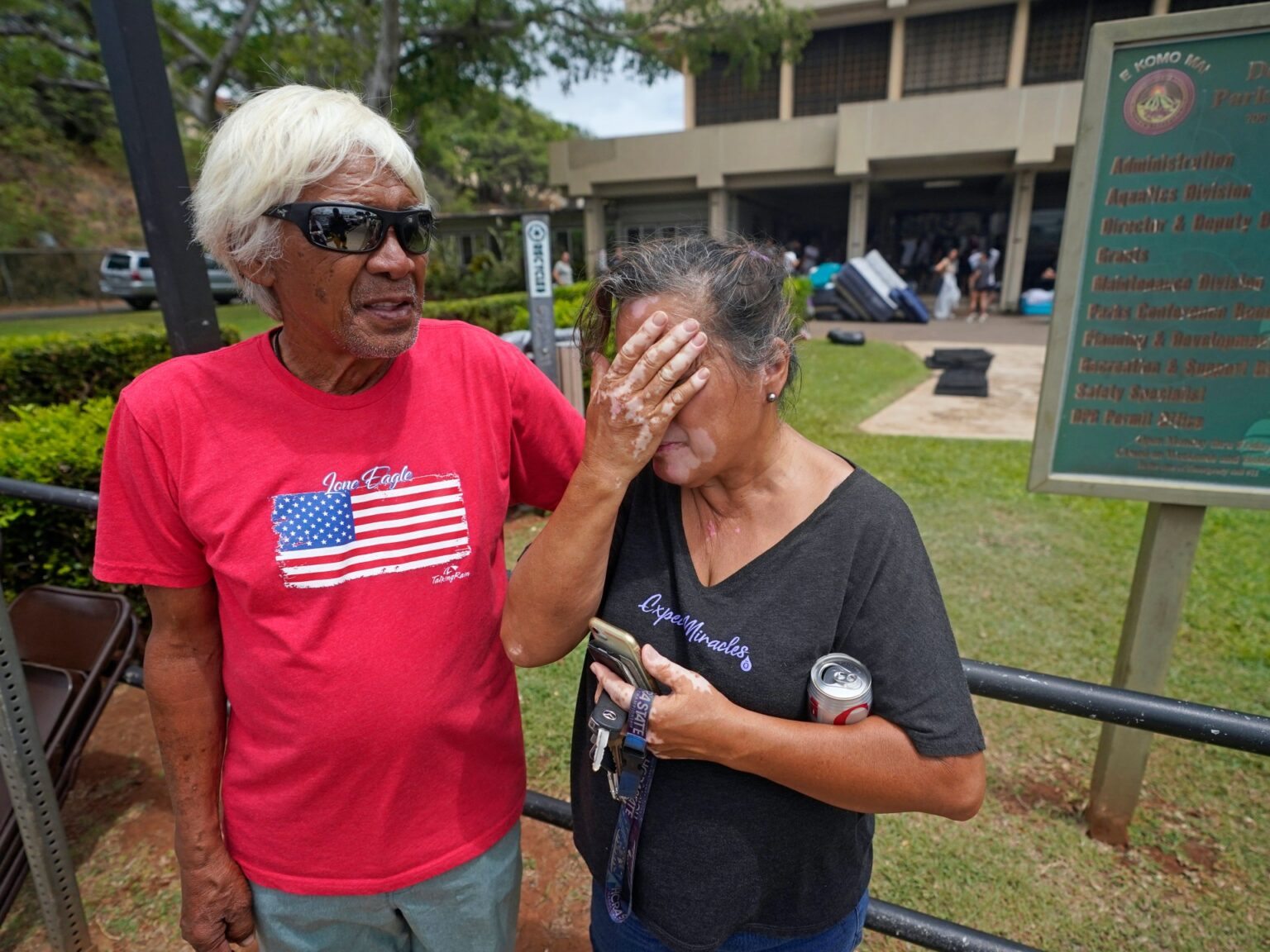As United States emergency crews continue to battle wildfires in Hawaii, residents and tourists have recounted their desperate escapes from wind-fuelled flames on the island of Maui, where some fled with nothing but the clothes on their backs.
Retired mailman and Vietnam war veteran Thomas Leonard lived in Lahaina, the historical capital of Hawaii, for 44 years until this week.
That is, until the rapidly moving wildfire that destroyed much of the town burned down his apartment, melted his Jeep and forced him to spend four terrifying hours hiding from the flames behind a seawall.
“I’ve got nothing left,” Leonard told The Associated Press as he sat on an inflatable mattress outside a shelter for those who fled the blaze. “I’m a disabled vet, so now I’m a homeless vet,” he added with a small laugh.
The fast-moving inferno, which started on Tuesday, spread from the brush outside of town and ravaged Lahaina. It was one of three major wildfires on Maui, all of them still burning, that were fuelled by dry conditions, a buildup of fuel, and 100 kilometres per hour (60 miles per hour) wind.
At least 55 people have been killed in the blazes, according to the latest tally from officials, but that death toll is expected to rise.
As firefighters continue to put out smaller fires, federal recovery dollars have started to flow along with an influx of supplies and equipment after US President Joe Biden on Thursday approved a disaster declaration for Hawaii.
Governor Josh Green said the inferno that reduced much of Lahaina to smoldering ruins was the worst natural disaster in the state’s history, making thousands of people homeless and levelling as many as 1,000 buildings.
“It’s going to take many years to rebuild Lahaina,” Green said during a news conference, as officials began to map out a plan to shelter the newly homeless in hotels and tourist rental properties.
Deborah Leoffler said she lost a home on Front Street, Lahaina’s main thoroughfare, that had been in her family since 1945. She evacuated so quickly that she left her debit cards on her nightstand and now cannot access her bank account.
“But I still have my family, and that’s what counts,” she told the AP.
‘A nightmare’
Elsewhere on the island, residents and tourists jumped into the Pacific Ocean to escape the flames. US Coast Guard commander Aja Kirksey told CNN about 100 people were believed to have fled into the water.
Kirksey said helicopter pilots struggled to see because of dense smoke, but that a Coast Guard vessel had been able to rescue more than 50 people from the ocean. “It was a really rapidly developing scene and pretty harrowing for the victims that had to jump into the water,” she added.

Among them was Vixay Phonxaylinkham, a tourist from Fresno, California, who said he was trapped in a rental car with his wife and children as the fires approached.
“We floated around four hours,” Phonxaylinkham said from the airport while awaiting a flight off the island, describing how they held onto pieces of wood for flotation.
“It was a vacation that turned into a nightmare. I heard explosions everywhere, I heard screaming, and some people didn’t make it. I feel so sad,” he said.
For resident Kekoa Lansford, the horror was far from over. “We still get dead bodies in the water floating and on the seawall,” Lansford told CBS. “We have been pulling people out.
“We’re trying to save people’s lives, and I feel like we are not getting the help we need.”
Many others also suffered burns, smoke inhalation and other injuries.
“It was so hot all around me, I felt like my shirt was about to catch on fire,” Nicoangelo Knickerbocker, a 21-year-old resident of Lahaina, said from one of the four emergency shelters opened on the island.
Knickerbocker heard cars and a petrol station explode, and soon after fled the town with his father, bringing with them only the clothes they were wearing and the family dog. “It sounded like a war was going on,” he said.
Uncertain future
For his part, Leonard, the retired mailman, said he did not know about the fire until he smelled smoke from his apartment on Front Street and went outside to investigate.
He had been in an information vacuum all day after the power had gone out early on Tuesday morning, leaving him and his neighbours without electricity, internet and mobile phone service.
He grabbed his wallet, keys and credit cards and jumped in his car to leave, only to find a traffic jam. He waited, in hopes the line of vehicles would move, until the cars ahead of him started exploding one by one.
“My Jeep had a soft top, and I knew it was going to go. And I just said, ‘I’m out of here,’” Leonard recalled.
The 74-year-old ran over to the seawall, joining about 70 others. About 20 of them jumped in the water to get away from the flames. Leonard said he felt safter crouched down next the wall on the ocean side, where he could let the wind carry hot ash over him.
Even so, cinders seared holes in his shorts and shirt, and he suffered burns on his legs. “There were flames coming and sparks everywhere,” he told the AP.
Leonard said he does not know if he will go back to Lahaina, especially given how long it will probably take to rebuild. “I have no idea where I’m going to go.”


